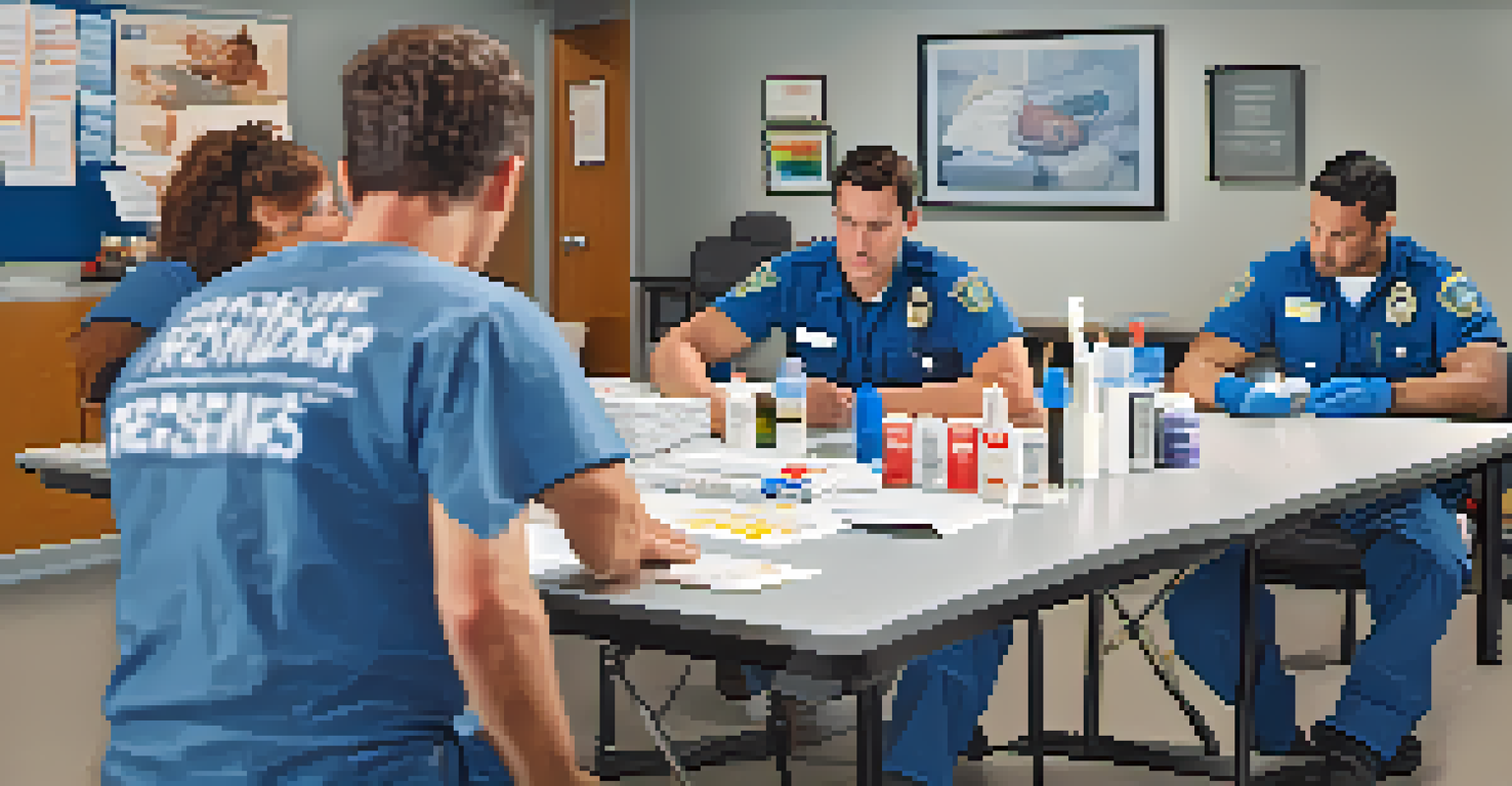Emergency Response Plans for Addiction Crises in Communities

Understanding Addiction Crises in Our Communities
Addiction crises can manifest in various forms, from overdose incidents to mental health emergencies. These situations not only affect the individual but can also ripple through families and neighborhoods, creating a sense of urgency for community intervention. Understanding the nuances of addiction, including its triggers and effects, is crucial for developing effective response strategies. By recognizing the signs and symptoms of addiction crises, communities can better prepare to handle these challenging situations.
Addiction is a family disease. One person may use, but the whole family suffers.
For example, think of addiction as a storm brewing on the horizon. Without awareness and preparation, that storm can hit hard, leaving destruction in its wake. However, if communities can identify the early signs of this storm, such as rising overdose rates or increased drug-related crime, they can mobilize resources and support before it escalates. This proactive approach is essential for safeguarding the well-being of community members.
Ultimately, acknowledging the complexity of addiction and its crises allows communities to approach the issue with empathy and understanding. This foundation of knowledge sets the stage for creating comprehensive emergency response plans that can effectively address the needs of those affected.
Components of a Comprehensive Emergency Response Plan
A well-structured emergency response plan for addiction crises should encompass several key components, including assessment, intervention, and follow-up. First, it's vital to assess the specific risks and resources available within the community. This may involve collaborating with local health departments, law enforcement, and addiction specialists to gain a clear understanding of the landscape.

Next, intervention strategies must be outlined, detailing how to respond during an addiction crisis. This might include establishing hotlines, training first responders in overdose recognition and naloxone administration, and creating safe spaces for individuals seeking help. By having these protocols in place, communities can act swiftly and effectively when crises occur.
Proactive Community Response is Key
Identifying early signs of addiction crises allows communities to mobilize resources and support before situations escalate.
Lastly, follow-up care is essential to ensure individuals receive ongoing support after their immediate crisis has been addressed. This could involve connecting them to treatment programs, counseling services, or peer support groups. By addressing both immediate and long-term needs, communities can foster recovery and prevent future crises.
Engaging Community Stakeholders for Effective Planning
Engaging community stakeholders is a fundamental aspect of developing an effective emergency response plan. Stakeholders may include healthcare providers, local businesses, schools, law enforcement, and, importantly, individuals with lived experience of addiction. By involving diverse perspectives, communities can create more comprehensive and inclusive strategies that resonate with those affected by addiction.
The greatest weapon against stress is our ability to choose one thought over another.
Consider a community potluck where everyone brings a dish to share. Each contribution adds to the overall meal, making it richer and more varied. Similarly, by bringing together different stakeholders, communities can harness a wealth of knowledge and resources that enrich the emergency response plan. This collaboration can lead to innovative solutions that might not have emerged in isolation.
Moreover, ongoing engagement encourages a sense of shared responsibility and ownership over the response plan. When stakeholders feel invested, they are more likely to contribute actively, whether through funding, resources, or volunteer efforts. This collective commitment strengthens the community's ability to respond effectively to addiction crises.
Training and Resources for First Responders
Training first responders is critical in ensuring they are prepared to handle addiction crises effectively. This training should cover not only the medical aspects of overdose response but also the psychological and emotional components involved when interacting with individuals facing addiction. By equipping first responders with a comprehensive skill set, communities can foster a more compassionate and effective approach to crisis management.
For instance, role-playing scenarios can be an effective training tool, allowing first responders to practice their skills in a safe environment. This method helps them develop the confidence and communication skills needed to engage with individuals in crisis empathetically. Moreover, ongoing training sessions can keep responders updated on the latest best practices and resources available.
Collaboration Enhances Recovery
Engaging stakeholders and treatment providers ensures a comprehensive response plan that addresses immediate and long-term needs.
Additionally, providing first responders with access to necessary resources, such as naloxone and mental health support, empowers them to act decisively during emergencies. By ensuring they have the tools and knowledge at their disposal, communities can enhance the effectiveness of their emergency response in addiction crises.
Creating Public Awareness Campaigns
Public awareness campaigns play a significant role in educating communities about addiction and available resources. By disseminating information through various channels—social media, schools, community events—these campaigns can help reduce the stigma surrounding addiction and encourage individuals to seek help when needed. The goal is to create a supportive environment where people feel comfortable discussing their struggles and accessing resources.
Think of public awareness campaigns as community lighthouses, guiding those lost in the fog of addiction towards safety and support. These campaigns can share stories of recovery and highlight local resources, showcasing that help is available and recovery is possible. By shining a light on these narratives, communities can inspire hope and resilience.
Moreover, engaging local media in these efforts can amplify the message and reach a wider audience. By collaborating with journalists and influencers, communities can ensure that important information about addiction crises and resources is shared effectively. This proactive communication helps foster a culture of understanding and support, ultimately leading to more effective response strategies.
Collaborating with Treatment Providers
Collaboration with treatment providers is essential for creating a seamless continuum of care for individuals in crisis. Establishing partnerships with local rehabilitation centers, mental health professionals, and support groups ensures that individuals have access to the resources they need immediately following a crisis. This collaboration can also facilitate smoother transitions from emergency care to long-term treatment.
For example, communities might set up referral systems that connect individuals in crisis directly to treatment providers. This ensures that individuals do not fall through the cracks after an emergency response. By having a clear pathway to care, communities can significantly improve recovery outcomes and reduce the likelihood of future crises.
Continuous Improvement Matters
Regular evaluation of emergency response plans helps communities learn from past experiences and refine strategies for better outcomes.
Additionally, ongoing communication between emergency responders and treatment providers can enhance overall response strategies. Regular meetings and information-sharing sessions can help both parties understand each other's roles and improve coordination during crises. This collaborative approach strengthens the community's ability to respond effectively to addiction crises and support those in need.
Evaluating and Improving Emergency Response Plans
Evaluating and continuously improving emergency response plans is vital to ensure their effectiveness over time. After each incident, communities should conduct thorough debriefs to assess what worked well and what could be improved. This reflective practice allows communities to learn from each experience and refine their strategies accordingly.
Consider this process like tuning a musical instrument. Just as musicians regularly adjust their instruments to achieve the best sound, communities must regularly assess and fine-tune their response plans. This ongoing evaluation can help identify gaps in training, resources, or communication that may hinder effective responses.

Moreover, gathering feedback from those directly impacted by addiction crises can provide invaluable insights. By listening to the voices of individuals in crisis, as well as their families and support networks, communities can better understand the effectiveness of their plans and make necessary adjustments. This commitment to continuous improvement ultimately leads to more effective and compassionate responses to addiction crises.